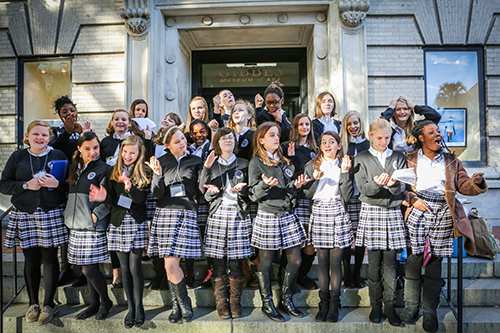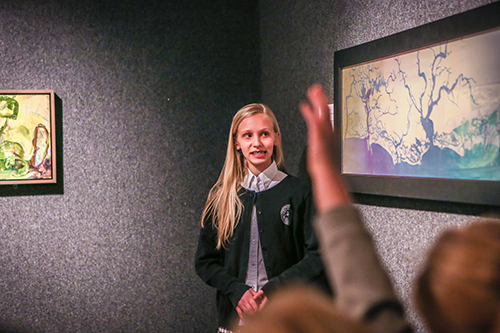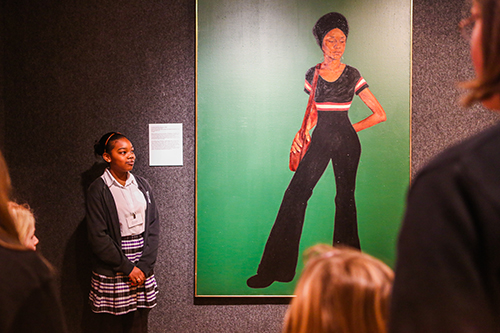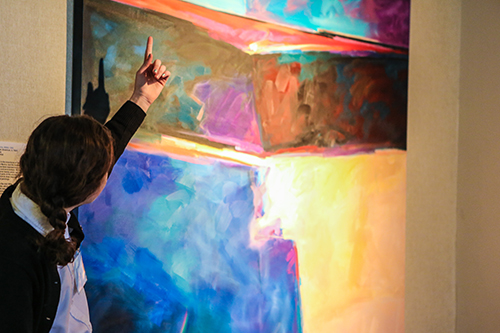In a city as vibrant and storied as Charleston, where history is said to live and artistic influence to breathe, it seems that we locals would be remiss to miss out on the enlightenment readily available in our own backyards. Lately, Charleston has proudly embraced a love of all things local, from local business to local produce. To me, it seems only logical that we equal-opportunity “locavores” should also indulge in the local cultural fare of our fair city. It was in this spirit that the History and English instructors of Ashley Hall’s 7th grade decided to orchestrate a local lowcountry exploration—leading our class on an adventure as “tourists” in their own town.

After studying the fundamental elements of art and architecture, the girls departed on a walking tour of the peninsula to put their new knowledge to the test. Equipped with widened eyes for art and armed with iPads poised for documentation, the class set out on foot, bundled up and bound for the Gibbes Museum of Art.
Once dubbed an “ornament to Charleston,” the Gibbes Museum has long served as a bastion of fine arts in this picturesque city. Today, the museum houses over 10,000 objects. The majority of these are tied in some way to the culture and history of South Carolina’s Lowcountry, hence the permanent exhibit’s title, The Charleston Story.
On this first trip, the girls were taken under the wings of seasoned museum docents Pat Burgess and Elise Detterbeck, who regaled them with tales of art and adventure, style and scandal, trends and broken traditions in the world of art. They led the group from gallery to gallery, bringing to life a story of Charleston than spanned centuries. The collective past they described was a vast one, told from many different perspectives and set against multiple backdrops, from the Plantation to the Sea Islands. The Charleston they described was multifaceted and marked by both astounding privilege and staggering oppression. The shared message of the exhibit resounded: the authentic “Charleston Story” can hardly be reduced to a single tale.
At the end of the training, it was apparent that what goes into adorning the walls of the Gibbes is far more complex than just picking out the prettiest pictures. In a matter of hours, the students began to appreciate the full force within the frames, and several voiced curatorial aspirations.

After the tour, students were given time to interact with the paintings individually. Stationed before a work of their choosing, each student mused about possibilities inspired by her favorite image and penned (or, rather, pecked out) a creative reflection to post and share on the class website. Soon enough, it was time to pack up and bid farewell to Charleston’s “ornament” of a museum and its spectacular contents.
The girls departed the Gibbes and set out on the second leg of their touristy romp: an architectural tour of the city led by Ashley Hall 7th grade history teacher Mary Webb that featured visits to the Edmundston-Alston House and the Charleston Library Society. With several miles—not to mention several centuries and countless facts—under our belts, we finally returned to Ashley Hall and the familiar territory of campus.

In the three short weeks that followed this inaugural visit, a transformation occurred: the once-tourists became the tour guides! After selecting a specific work from the Gibbes’s collection, the girls dove into a full-fledged research project, digging for information, evaluating sources, and piecing together their findings. Through resourceful research, several students were able to contact their more contemporary artists firsthand, and 7th grader Hannah was able to strike up a conversation with renowned photographer and environmentalist speaker J. Henry Fair that ultimately resulted in a visiting lecture for the entire Upper School. Finally, students were ready to present their research for their peers in preparation for the big show: a docent tour for a live audience.
On the presentation day, the students were joined by an enthusiastic audience that included family, friends, and an entire class of first grade buddies or “little sisters” from Ashley Hall. With this group, the junior docents shared both a wealth of knowledge and a fun-filled afternoon.

A particularly special moment occurred when featured artist Eva Carter showed up to watch 7th grade student Grace as she presented Carter’s exhibited painting “Highway Blues.” When Carter initiated a round of applause in approval of Grace’s presentation, it seemed to echo my own euphoric sentiments: They nailed it! The performances not only dazzled me, but also impressed museum educators: Pat and Elise called Ashley Hall’s docent work “eye-opening” and “confident,” and Gibbes Head Educator Rebecca Sailor reported being “blown away” by the tours.
The girls were also proud of themselves. Here’s what they had to say about the project:
“I was amazed by how confident everyone was while presenting. We really knew the information and it was fun seeing our little sisters’ reactions to the art.”—Ella, 7th grade
“Our presentations were to the point, informative, and interactive. Our little sisters seemed excited to learn more!”—Olivia, 7th grade
“The best part of my project was when I got to email my artist, Jonathan Green, and find out why he painted the way he did.”—Chasity, 7th grade
“The best part of the project was when I got to meet my artist, Eva Carter!”—Grace, 7th grade
“The best part of this project was going to the museum the first day because I love the pieces of artwork at the Gibbes and loved getting to go there.”—Brooke, 7th grade
“The best part of the project was getting to walk around Charleston because it is a beautiful city that we often take for granted.”—Lou Lou, 7th grade
In the wake of our Gibbes Junior Docent project experience, I hope these students continue to nourish the instinct they cultivated in the museum to always look again—to give a second glance to the things before them-whether this be a work of art, an idea, a person, a story, or even a hometown—and to greet the world around them with ever-widening eyes.
—Anne Rhett, Ashley Hall Upper School Faculty Member, English Department, and guest blogger
Published March 22, 2013

